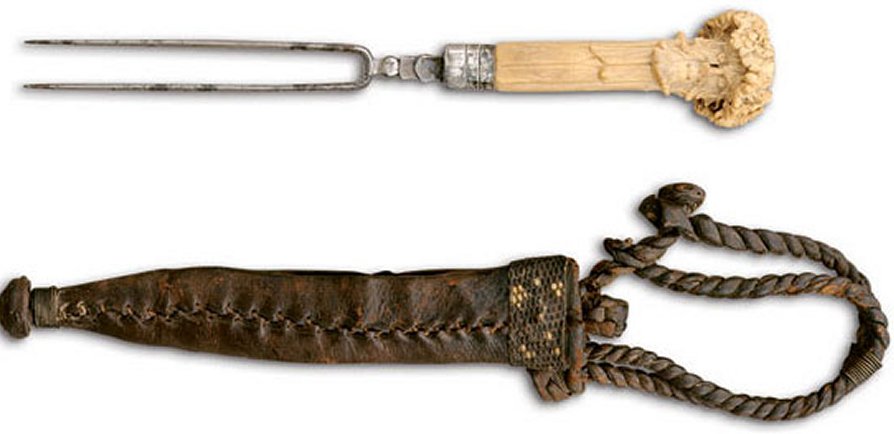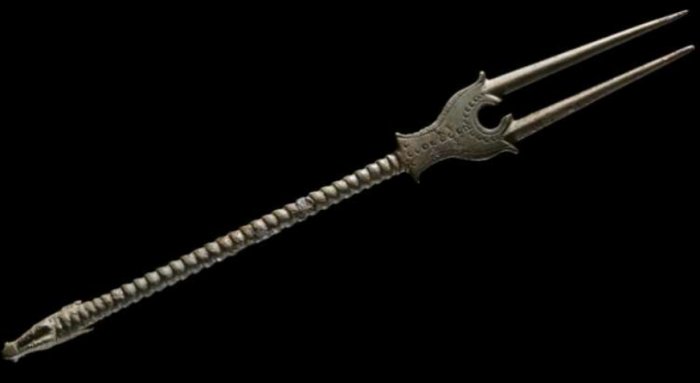Troublesome Ancient History Of Forks That Were Long A Shocking Sensation
A. Sutherland - AncientPages.com - Should you eat the food using five or three fingers? You should use a fork. At the beginning, a fork did not gain many enthusiasts in Europe.
 Fork and leather case. Southern Germany or Austria, mid-18th century. Image via cooperhewitt.org
Fork and leather case. Southern Germany or Austria, mid-18th century. Image via cooperhewitt.org
What is the history of the fork?
When the first forks appeared, they caused a sensation, but getting people to use them for eating was not easy. Not only were forks very expensive, but they even had a number of enemies, and one of them was the Church, which banned the use of the fork.
The Church disliked forks and argued that God had created humans with fingers so they could touch and eat God’s food. The Church’s disapproval did not stop people from producing gold and silver forks that wealthy families in Tuscany wanted to have at the dining table.
Still, many people did not know how to use them. For many, the fork was still considered a strange, dangerous, and very useless tool and could not gain much popularity.
This situation lasted until the 15th century, and it was the time when Europeans found that cutlery did not have much to do with the devil. However, it has gained popularity because the spoon played the most important role at the time, and solid foods were eaten with the help of the hand.
Forks appeared only at the royal and magnate courts in Italy. A century later, the fork arrived in France and had only two teeth used to impale the meat. Later, the fork gained a third tooth – a sign of the commonly used method of eating with three fingers. Gradually, different varieties of this cutlery were created. One such fork was shaped in the form of a cake fork.
Old etiquette books advised people not to eat soup with a fork. So, one can imagine how confused people must have been when a fork was put on the dining table.
Forks molded bronze and stamped decoration excavated in the remains of the ancient city of Susa. Musée du Louvre. Image credit: Marie-Lan Nguyen - Public domain
Ancient people ate with their fingers. You could do it the right or wrong way. How many fingers were used for eating was one of the marks that distinguished the upper and lower classes.
The most common was to grab the food and eat it with five fingers, but from Roman times onward, eating with three fingers was considered good manners.
In the 1530s, an etiquette book even described the “three-finger rule.” People were reminded of the importance of using the correct number of fingers when dining in a good society.
Tableware was long unheard of. The use of forks for eating had yet to be considered.
The oldest forks were discovered in Çatalhöyük (eller Çatal Hüyük), Turkey. Scientists dated the artifacts to the fourth millennium B.C., but researchers concluded it was unlikely the primitive forks were used for eating. It is more likely they were used as ancient tools. Some Persian nobility may have used a forklike tool in the eighth or ninth century.
Copper alloy fork; two pronged and decorated; twisted ergonomic handle grip with oval section, ending in a miniature head of a horned animal and, at the other, a pair of tines with ovoid-circular sections. Late Sasanian. 6thC-7thC - Excavated by: George Smith - South West Palace (Nineveh). Length 20.2, width 2.40 cm - From Kuyunjik, Nineveh in northern Iraq. Image source: British Museum
The word “fork” comes from the Latin furca, a farmer’s pitchfork. It was first used for eating in the 11th century in Tuscany, Italy.
The fork was a shocking sensation for at least a hundred years.
Before being murdered, Thomas Becket, Archbishop of Canterbury, introduced the fork to England and King Henry II, but Englishmen were not impressed and sometimes even suspicious.
According to some legends, noblemen at the court used the forks for dueling. Whether this is true or just a myth has yet to be discovered.
Steel French forks dating from the late 1500s to the early 1600s, with mother-of-pearl and beads. Image credit: V&A MuseumWhat is historically confirmed is that the fork was an expensive, decorative curiosity from Italy, and few could afford it.
King Edward I owned thousands of royal knives and hundreds of spoons but only seven forks. Six of these were made of silver, and one was of gold. King Charles V of France owned 12 forks.
Forks were not readily accepted in Europe. They were expensive, often ridiculed, and many needed help with how and when to use them. In popular etiquette books, advice was given: “Do not try to eat soup with a fork.”
Only in the 18th century did forks become accepted at the dining table—more and more families, even from the poorer classes, owned forks.
Today, we find it hard to imagine we can eat dinner without a fork, but not so long ago, the situation was much different.
Written by – A. Sutherland AncientPages.com Staff Writer
Copyright © AncientPages.com All rights reserved. This material may not be published, broadcast, rewritten or redistributed in whole or part without the express written permission of AncientPages.com
Expand for referencesReferences:
Wilson B. Consider the Fork: A History of How We Cook and Eat
More From Ancient Pages
-
 Seti I – Remarkable Pharaoh Who Saved The Kingdom Of Egypt And Gave It New Glory
History | Jun 15, 2021
Seti I – Remarkable Pharaoh Who Saved The Kingdom Of Egypt And Gave It New Glory
History | Jun 15, 2021 -
 Pharaoh Hatshepsut: Skillful And Efficient Female Ruler Who Brought Prosperity To Ancient Egypt
Featured Stories | Mar 22, 2017
Pharaoh Hatshepsut: Skillful And Efficient Female Ruler Who Brought Prosperity To Ancient Egypt
Featured Stories | Mar 22, 2017 -
 Well-Preserved Fragments Of Epetion’s Wall Discovered At The Hellenistic Site Of Stobreč, Near Split, Croatia
Archaeology | Oct 11, 2024
Well-Preserved Fragments Of Epetion’s Wall Discovered At The Hellenistic Site Of Stobreč, Near Split, Croatia
Archaeology | Oct 11, 2024 -
 Why Didn’t Alexander The Great’s Body Show Signs Of Decomposition For Several Days? A Never-Before Suggested Explanation – From Scientists
Archaeology | Jan 24, 2019
Why Didn’t Alexander The Great’s Body Show Signs Of Decomposition For Several Days? A Never-Before Suggested Explanation – From Scientists
Archaeology | Jan 24, 2019 -
 Keeladi, India: Ancient Residents Along Vaigai River Had Adopted Highly Progressive Technologies
Archaeology | Aug 28, 2020
Keeladi, India: Ancient Residents Along Vaigai River Had Adopted Highly Progressive Technologies
Archaeology | Aug 28, 2020 -
 How ‘Listening’ To Archaeological Sites Could Shed Light On The Past
Archaeology | Dec 8, 2023
How ‘Listening’ To Archaeological Sites Could Shed Light On The Past
Archaeology | Dec 8, 2023 -
 Researchers Confirm Museum Shrunken Head As Human Remains
Archaeology | Aug 4, 2022
Researchers Confirm Museum Shrunken Head As Human Remains
Archaeology | Aug 4, 2022 -
 Ancient Maya Ballcourts And Evidence Of Ceremonial Plant Species Offerings
Ancient Traditions And Customs | Apr 29, 2024
Ancient Maya Ballcourts And Evidence Of Ceremonial Plant Species Offerings
Ancient Traditions And Customs | Apr 29, 2024 -
 Susa: One Of The World’s Oldest Cities That Served As Capital Of The Elamite Empire
Featured Stories | Oct 14, 2023
Susa: One Of The World’s Oldest Cities That Served As Capital Of The Elamite Empire
Featured Stories | Oct 14, 2023 -
 King Lud – Mysterious Founder Of London And His Connection To The Tuatha De Danann
Featured Stories | Oct 21, 2021
King Lud – Mysterious Founder Of London And His Connection To The Tuatha De Danann
Featured Stories | Oct 21, 2021 -
 Who Were The Blue People Of Kentucky?
Featured Stories | Apr 5, 2022
Who Were The Blue People Of Kentucky?
Featured Stories | Apr 5, 2022 -
 Saint George: Knight Warrior Who Refused To Denounce His Faith And Died A Martyrs Death
Featured Stories | Jun 3, 2019
Saint George: Knight Warrior Who Refused To Denounce His Faith And Died A Martyrs Death
Featured Stories | Jun 3, 2019 -
 Indus Valley Civilization Far Ahead Of Its Time Has Baffled Scientists For Centuries
Ancient Technology | May 18, 2017
Indus Valley Civilization Far Ahead Of Its Time Has Baffled Scientists For Centuries
Ancient Technology | May 18, 2017 -
 The Majestic Lion: Ancient Symbol Of Power And Royalty Found World-Wide
Ancient Symbols | Oct 10, 2017
The Majestic Lion: Ancient Symbol Of Power And Royalty Found World-Wide
Ancient Symbols | Oct 10, 2017 -
 Ancient Maya People Used Volcanic Ash To Build Pyramids When Huge Eruption Occurred
Archaeology | Sep 22, 2021
Ancient Maya People Used Volcanic Ash To Build Pyramids When Huge Eruption Occurred
Archaeology | Sep 22, 2021 -
 The Unicorn In The Bible Was An Oryx – Ancient Translation Mistake
Ancient History Facts | Apr 24, 2018
The Unicorn In The Bible Was An Oryx – Ancient Translation Mistake
Ancient History Facts | Apr 24, 2018 -
 Underwater Jars Reveal Roman Period Winemaking Practices
Archaeology | Jun 30, 2022
Underwater Jars Reveal Roman Period Winemaking Practices
Archaeology | Jun 30, 2022 -
 Amazing Ancient Roman Marble Floor Found In The Underwater City Of Baiae, Italy
Archaeology | Aug 5, 2024
Amazing Ancient Roman Marble Floor Found In The Underwater City Of Baiae, Italy
Archaeology | Aug 5, 2024 -
 Vindelev Treasure Re-Writes Ancient History – World’s Oldest Runic Inscription Of God Odin Found On Ancient Gold Pendants
Archaeology | Mar 8, 2023
Vindelev Treasure Re-Writes Ancient History – World’s Oldest Runic Inscription Of God Odin Found On Ancient Gold Pendants
Archaeology | Mar 8, 2023 -
 Mystery Of The Stone Of Destiny Solved – It Was Originally A Doorstep!
Archaeology | May 2, 2024
Mystery Of The Stone Of Destiny Solved – It Was Originally A Doorstep!
Archaeology | May 2, 2024



